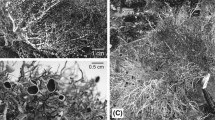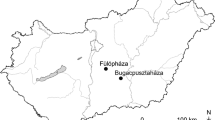Abstract
Our knowledge of the ecophysiology of photosynthetic production of Antarctic lichens is based on separate investigations made with species from the maritime Antarctic or species from the continental Antarctic, but no studies have yet been made comparing the same or similar species in both areas. Many data have been published from field and laboratory measurements on Signy Island, although much less about lichens (Lindsay, 1978; Hooker, 1980a,b,c) than about bryophytes (Baker, 1972; Collins, 1977; Collins and Callaghan, 1980; Fenton, 1980). With respect to the continental Antarctic there are more studies on lichens (Gannutz, 1970; Lange and Kappen, 1972; Schofield and Ahmadjian, 1972; Kappen 1983a; Kappen and Friedmann, 1983) than on mosses (Rastorfer, 1970; Longton, 1974; Ino, 1983). Climate and ecological conditions are very different in the two areas, particularly the winter conditions. In the maritime Antarctic, as the author has seen on King George Island, the abundance and variety of lichens is remarkable. In continental Antarctica, even near the coast of northern Victoria Land (Kappen, 1983b) lichens may be considered to be extremely resistant representatives of a pioneer vegetation in a polar desert. Consequently, the aim of this study was to evaluate whether lichens show adaptive physiological differences or whether they have the same physiological and ecological requirements in the polar desert and the maritime Antarctic due to presumably convergent habitat conditions.
Access this chapter
Tax calculation will be finalised at checkout
Purchases are for personal use only
Preview
Unable to display preview. Download preview PDF.
Similar content being viewed by others
References
Anon ., 1977, Boletin Meterologico de la Fuerza Aérea de Chile, Centro Meteorologico Presidente Frei (“BMF AC-report”).
Baker, J.H., 1972, The rate of production and decomposition of Chorisodontium aciphyllum(Hook f. and Wils.), Broth., British Antarctic Survey Bulletin, 27:123–129.
Billings, W.D., 1974, Arctic and alpine vegetation: plant adaptations to cold summer climates, in: “Arctic and alpine environments,” Ives, J.D. and Barry, R.G. eds, pp.403–443, Methuen.
Brown, D., and Kershaw, K.A., 1984, Photosynthetic capacity changes in Peltigera. 2. Contrasting season patterns of net photosynthesis in two populations of Peltigera rufescens, New Phytologist, 96:447–457.
Collins, N.J., 1977, The growth of mosses in two contrasting communities in the maritime Antarctic: Measurement and prediction of net annual production, in: “Adaptations within Antarctic ecosystems,” Llano, G.A. ed., pp.921–933, Proc. 3rd S.C.A.R. Symposium, Smithsonian Institution Washington D.C.
Collins, N.J., and Callaghan, T.V., 1980, Predicted patterns of photosynthetic production in maritime Antarctic mosses, Annals of Botany, 45: 601–620.
Fenton, J.H.C., 1980, The rate of peat accumulation in Antarctic moss banks, Journal of Ecology, 68:211–228.
Gannutz, T.P ., 1970, Photosynthesis and respiration of plants in the Antarctic peninsula area, Antarctic Journal of the US, 5: 49–51.
Green, T.G.A., Horstmann, J., Bonnet, H., Wilkins, A., and Silvester, W.B., 1980, Nitrogen fixation by members of the Stictaceae (Lichenes) of New Zealand, New Phytologist, 84:339–348.
Hooker, T.N., 1980a, Factors affecting the growth of antarctic crustose lichens, British Antarctic Survey Bulletin, 50:1–19.
Hooker, T.N., 1980b, Growth and production of Cladonia rangiferinaand Sphaerophorus globosuson Signy Island, South Orkney Islands, British Antarctic Survey Bulletin, 50:27–34.
Hooker, T.N., 1980c, Growth and production of Usnea antarcticaand U. fasciataon Signy Island, South Orkney Islands, British Antarctic Survey Bulletin, 50:35–49.
Ino, Y., 1983, Photosynthesis and primary production in moss community at Syowa Station, Antarctica, Japanese Journal of Ecology, 33:427–433.
Kappen, L., 1983a, Ecology and physiology of the Antarctic fruticose lichen Usnea sulphurea(Koenig) Th. Fries, Polar Biology, 1:249–255.
Kappen, L., 1983b, Anpassungen von Pflanzen an kalte Extremstandorte, Berichte der Deutschen Botanischen Gesellschaft, 96:87–101.
Kappen, L., 1984, Vegetation and ecology of ice-free areas of northern Victoria Land, Antarctica. II. Ecological conditions in typical microhabitats of lichens at Birthday Ridge. Polar Biology, (submitted).
Kappen, L., and Friedmann, E.I., 1983, Kryptoendolithische Flechten als Beispiel einer Anpassung an extrem trocken-kalte Klimabedingungen, Verhandlungen der Gesellschaft för Ökologie (Mainz 1981), 10:517–519.
Lamb, I.M., 1964, Antarctic lichens, 1. The genera Usnea, Ramalina, Himantormia, Alectoria, Cornicularia, British Antarctic Survey Scientific Report, 38:1–34.
Lange, O.L., 1980, Moisture content and CO2 exchange of lichens. I. Influence of temperature on moisture-dependent net photosynthesis and dark respiration in Ramalina maciformis, Oecologia, 45:82–87.
Lange, O.L., and Kappen, L., 1972, Photosynthesis of lichens from Antarctica, Antarctic Research Series, 20:83–95.
Lange, O.L., Schulze, E.-D., and Koch, W., 1970, Experimentell-ükologische Untersuchungen an Flechten der Negev Wüste: II. CO2 Gaswechsel und Wasserhaushalt von Ramalina maciformis(Del). Bory, Flora, 159:38–62.
Lindsay, D.C., 1978, The role of lichens in Antarctic ecosystems, The Bryologist, 81: 268–276.
Longton, R.E., 1974, Microclimate and biomass in communities of the Bryum association on Ross Island, continental Antarctica, The Bryologist, 77:109–127.
Rastorfer, J.R., 1970, Effects of light intensity and temperature on photosynthesis and respiration of two east Antarctic mosses, Bryum argenteumand Bryum antarcticum, The Bryologist, 73:544–556.
Schofield, E., and Ahmadjian, V., 1972, Field observation and laboratory studies of some Antarctic cold desert cryptogams, Antarctic Research Series, 20:97–142.
Author information
Authors and Affiliations
Editor information
Editors and Affiliations
Rights and permissions
Copyright information
© 1985 Plenum Press, New York
About this chapter
Cite this chapter
Kappen, L. (1985). Water Relations and Net Photosynthesis of Usnea. A Comparison between Usnea Fasciata (Maritime Antarctic) and Usnea Sulphurea (Continental Antarctic). In: Brown, D.H. (eds) Lichen Physiology and Cell Biology. Springer, Boston, MA. https://doi.org/10.1007/978-1-4613-2527-7_4
Download citation
DOI: https://doi.org/10.1007/978-1-4613-2527-7_4
Publisher Name: Springer, Boston, MA
Print ISBN: 978-1-4612-9526-6
Online ISBN: 978-1-4613-2527-7
eBook Packages: Springer Book Archive




